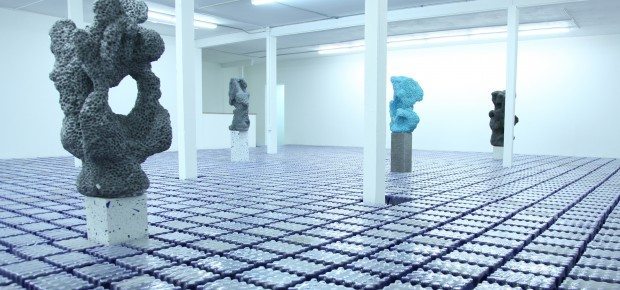Nicolas Lobo featured in Black Book

If you’ve ever wondered what the connection between napalm, Chinese philosophers, and “sexual energy” drinks is, look no further than Nicolas Lobo‘s “Bad Soda / Soft Drunk” exhibition, opening tonight at Gallery Diet in Miami. The space has been specially adapted for the show; in order to get close to Lobo’s series of napalm-and-polystyrene sculptures, viewers must walk stacked crates ofNexcite, described as a “discontinued, obscure brand of energy drink marketed for its aphrodisiac qualities to women.” (Lobo is no stranger to weird, ingestible chemical concoctions; previous video works have incorporated grape cough syrup as a medium). The installation brings to mind Cyprian Galliard’s epic beer-based sculpture at KW Berlin, and certainly taps into the art world’s ongoing, unexpected flirtation with energy drink culture. I asked Lobo a bit more about the enigmatic connections at play in “Bad Soda / Soft Drunk.”
Can you describe a bit of the technical process behind the napalm sculptures?
The shapes of the sculptures are created by the production of Napalm-B. They begin as blocks of polystyrene and I pour on a mixture of gasoline with some additives; the blocks melt and erode until I decide I like the shape and stop pouring gasoline. This is essentially the same formula that was used in Vietnam as well as other conflicts of that time.
Speaking of Vietnam, it’s hard to avoid that reference. Were you thinking about that war—or war in general—when making these works, or is your connection to the chemical a purely formal one? Is it possible to look at a material like this without thinking of its history?
I agree, it is difficult to avoid the associations with war when thinking about napalm, but with these sculptures I’m not trying to engage the subject of war directly. What I am interested in is the psychological understanding of the substance by humans, most of whom have never seen or experienced napalm in any way. A lot of people are familiar with [the line] “The smell of napalm in the morning” thanks to Francis Ford Copolla, but how many are familiar with the smell of napalm? These are the kinds of questions that keep coming up for me. It has become a mythological substance that allows for the illusion of understanding. I or anyone who has not experienced this horrible gel in the way it was designed to be used has no idea whatsoever about napalm. It is this cognitive slippage that I’m interested in and trying to get at with this work.
How does the “Windex-blue” character of the highly-artificial Nexcite play off against the sculptural materials? Have you sampled Nexcite yourself? What sets a sexual energy drink apart from a regular old energy drink, like Red Bull?
I’d like to know more about beverage marketing and design, it’s at least as fascinating as pharmaceutical naming trends. Personally, I tried a bottle of Nexcite and found it completely undrinkable, though to be fair the bottle was 13 years past its expiration date. What I’m really interested in, with drinks in particular, is the investment of physiological qualities–in this case a sexual quality—to something which consists entirely of an aesthetic experience (the color, the taste, the smell, etceteras). I think sex has been an undercurrent of all soft drinks since the beginning in varying levels, but what is interesting about Nexcite is that not only was it sexualized, it was gendered as a female aphrodisiac.
The other stated reference that you make in the press materials, referring to the sculptures, is to Chinese scholar stones, which adds another temporal layer to what’s already there (a discontinued energy drink from the ’90s, a war material popularized in the ’60s…) How does the idea of these stones tie in with the other elements?
I think the stones are really interesting because the tradition is to use the shape of the stone as a tactile tool for philosophical contemplation. It’s again this idea of the disconnect between the intellectual mind and physical experience, but in this case its trying to bridge that. I like your idea of temporal layers, the stones being the bottom or earliest layer in the show; speaking to that I would add that the connoisseurship and use of the stones varied greatly across the generations of the tradition. It seems like another form of the trend cycles we encounter today, weather in beverages, weapons, or otherwise.
Nicolas Lobo’s exhibition is on view at Gallery Diet through March 29.